engine MITSUBISHI ASX 2015 Owner's Manual (in English)
[x] Cancel search | Manufacturer: MITSUBISHI, Model Year: 2015, Model line: ASX, Model: MITSUBISHI ASX 2015Pages: 452, PDF Size: 20.1 MB
Page 365 of 452

lUse engine oil conforming to the follow-
ing classification: • ACEA classification: “For service C1, C2, C3 or C4”
• JASO classification: “For service DL-1”
If those classifications are not available,
contact a MITSUBISHI MOTORS Au-
thorized Service Point.NOTEl Use of additives is not recommended since
they may reduce the effectiveness of addi-
tives already included in the engine oil. It may result in failure of the mechanical as-
sembly.Engine coolant
E01000503437
To check the coolant level
A transparent coolant reserve tank (A) is lo-cated in the engine compartment.
The coolant level in this tank should be kept
between the “LOW” and “FULL” marks when measured while the engine is cold.To add coolant
The cooling system is a closed system andnormally the loss of coolant should be very
slight. A noticeable drop in the coolant level
could indicate leakage. If this occurs, we rec- ommend you to have the system checked as
soon as possible.
If the level should drop below the “LOW” level on the reserve tank, open the lid and
add coolant.
Also, if the reserve tank is completely empty, remove the radiator cap (B) and add coolant until the level reaches the filler neck.
WARNINGl Do not open the radiator cap (B) while the
engine is hot. The coolant system is under
pressure and any hot coolant escaping
could cause severe burns.
Anti-freeze
The engine coolant contains an ethylene gly-
col anti-corrosion agent. Some parts of the engine are cast aluminium alloy, and periodic
changing of the engine coolant is necessary to prevent corrosion of these parts.
Engine coolant
10-07OGAE15E5Maintenance10 Except for diesel-powered vehicles 1600 models
FULLLOW Diesel-powered vehicles 1600 modelsFULLLOW
Page 366 of 452
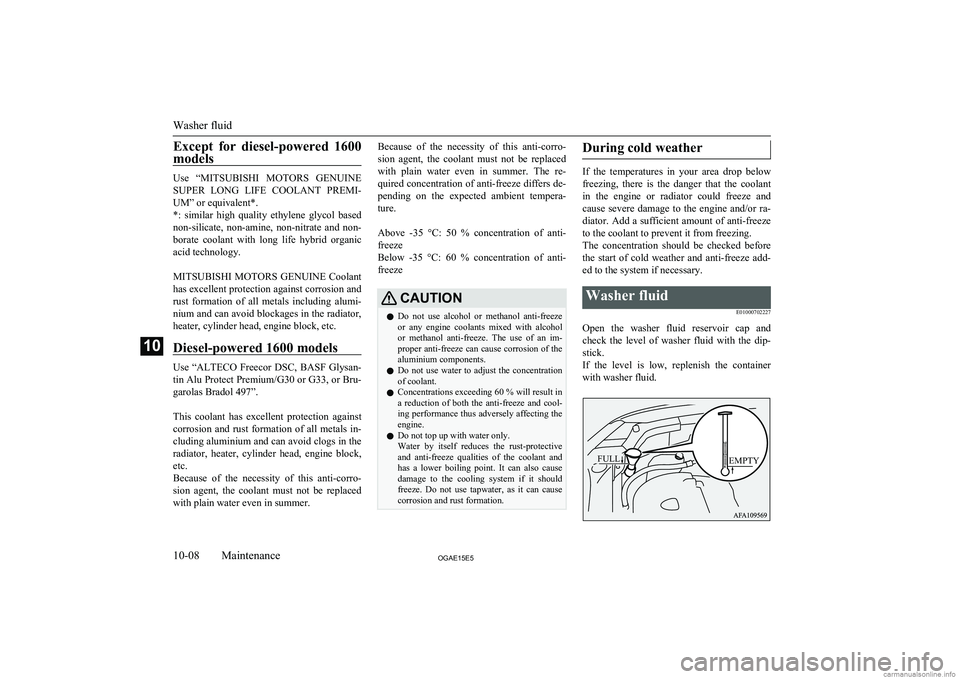
Except for diesel-powered 1600models
Use “ MITSUBISHI MOTORS GENUINE
SUPER LONG LIFE COOLANT PREMI-
UM” or equivalent*.
*: similar high quality ethylene glycol based
non-silicate, non-amine, non-nitrate and non- borate coolant with long life hybrid organic acid technology.
MITSUBISHI MOTORS GENUINE Coolant
has excellent protection against corrosion and rust formation of all metals including alumi-
nium and can avoid blockages in the radiator,
heater, cylinder head, engine block, etc.
Diesel-powered 1600 models
Use “ALTECO Freecor DSC, BASF Glysan- tin Alu Protect Premium/G30 or G33, or Bru-
garolas Bradol 497”.
This coolant has excellent protection against
corrosion and rust formation of all metals in-
cluding aluminium and can avoid clogs in the
radiator, heater, cylinder head, engine block,
etc.
Because of the necessity of this anti-corro-
sion agent, the coolant must not be replaced with plain water even in summer.
Because of the necessity of this anti-corro-
sion agent, the coolant must not be replaced with plain water even in summer. The re-
quired concentration of anti-freeze differs de-
pending on the expected ambient tempera- ture.
Above -35 °C: 50 % concentration of anti-
freeze
Below -35 °C: 60 % concentration of anti-
freezeCAUTIONl Do not use alcohol or methanol anti-freeze
or any engine coolants mixed with alcohol or methanol anti-freeze. The use of an im-
proper anti-freeze can cause corrosion of the aluminium components.
l Do not use water to adjust the concentration
of coolant.
l Concentrations exceeding 60 % will result in
a reduction of both the anti-freeze and cool-
ing performance thus adversely affecting the engine.
l Do not top up with water only.
Water by itself reduces the rust-protective
and anti-freeze qualities of the coolant and has a lower boiling point. It can also causedamage to the cooling system if it should freeze. Do not use tapwater, as it can causecorrosion and rust formation.During cold weather
If the temperatures in your area drop below
freezing, there is the danger that the coolant
in the engine or radiator could freeze and cause severe damage to the engine and/or ra-diator. Add a sufficient amount of anti-freeze
to the coolant to prevent it from freezing. The concentration should be checked before the start of cold weather and anti-freeze add- ed to the system if necessary.
Washer fluid
E01000702227
Open the washer fluid reservoir cap andcheck the level of washer fluid with the dip- stick.
If the level is low, replenish the container with washer fluid.
Washer fluid
10-08OGAE15E5Maintenance10 FULLEMPTY
Page 377 of 452

General maintenanceE01002700520
Fuel, engine coolant, oil and ex- haust gas leakage
Look under the body of your vehicle to check
for fuel, engine coolant, oil and exhaust gas
leaks.
WARNINGl If you see a suspicious fuel leak or if you
smell fuel, do not operate the vehicle; call
your MITSUBISHI MOTORS Author-
ized Service Point for assistance.
Exterior and interior lamp op-
eration
Operate the combination lamp switch to
check that all lamps are functioning properly.
If the lamps do not illuminate, the probable cause is a blown fuse or defective lamp bulb.
Check the fuses first. If there is no blown
fuse, check the lamp bulbs.
For information regarding the inspection and
replacement of the fuses and the lamp bulbs, refer to “Fuses” on page 10-20 and “Re-
placement of lamp bulbs” on page 10-26.
If the fuses and bulbs are all OK, we recom-
mend you to have your vehicle checked and
repaired.
Meter, gauge and indicator/warning lamps operation
Start the engine and check the operation of all instruments, gauges and indication andwarning lamps.
If there is anything wrong, we recommend you to have your vehicle inspected.
Hinges and latches lubrication
Check all latches and hinges, and, if necessa- ry, have them lubricated.
For cold and snowy weather
E01002800361
Ventilation slots
The ventilation slots in front of the wind-
screen should be kept clear of leaves or brushed clear after heavy snowfall, so that
the operation of the heating and ventilation
systems will not be impaired.
Weatherstripping
To prevent freezing of the weatherstripping
on the doors, bonnet, etc., they should be treated with silicone grease.
Additional equipment
It is a good idea to carry a shovel or a short-
handled spade in the vehicle during the win- ter so that you can clear away snow if you get stranded. A small hand-brush for sweeping
snow off the vehicle and a plastic scraper for the windscreen and rear window are also use-ful.
Fusible links
E01002900564
The fusible links will melt to prevent a fire if
a large current attempts to flow through cer- tain electrical systems.
In case of a melted fusible link, we recom- mend you to have your vehicle inspected.
For the fusible links, please refer to “Fuse
load capacity” on page 10-22.
General maintenance
10-19OGAE15E5Maintenance10
Page 378 of 452
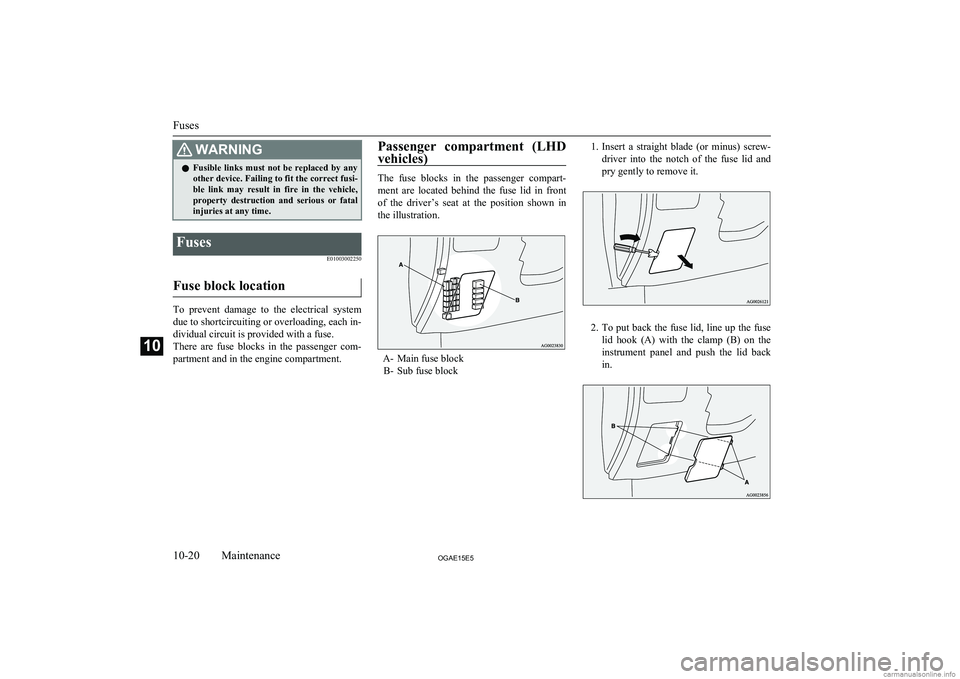
WARNINGlFusible links must not be replaced by any
other device. Failing to fit the correct fusi-
ble link may result in fire in the vehicle,
property destruction and serious or fatal injuries at any time.Fuses
E01003002250
Fuse block location
To prevent damage to the electrical systemdue to shortcircuiting or overloading, each in-
dividual circuit is provided with a fuse.
There are fuse blocks in the passenger com-
partment and in the engine compartment.
Passenger compartment (LHD
vehicles)
The fuse blocks in the passenger compart- ment are located behind the fuse lid in front
of the driver’s seat at the position shown in the illustration.
A- Main fuse block B- Sub fuse block
1. Insert a straight blade (or minus) screw-
driver into the notch of the fuse lid and pry gently to remove it.
2. To put back the fuse lid, line up the fuse
lid hook (A) with the clamp (B) on the
instrument panel and push the lid back in.
Fuses
10-20OGAE15E5Maintenance10
Page 380 of 452

Engine compartment
In the engine compartment, the fuse block islocated as shown in the illustration.
1- Push the knob.
2- Remove the cover.
Fuse load capacity
E01007701870
The fuse capacity and the names of electrical systems protected by the fuses are indicated
on the inside of the fuse lid (LHD vehicles), the inside of the glove box (RHD vehicles)
and inside of the fuse block cover (inside of the engine compartment).
Passenger compartment fuse lo-
cation tableNOTEl Spare fuses are provided on the lid of the
fuse block in the engine compartment. Al-ways use a fuse of the same capacity for re-
placement.Passenger compartment fuse location (LHD)Main fuse blockSub fuse blockPassenger compartment fuse location (RHD)Sub fuse blockMain fuse block
No.Sym-
bolElectrical sys- temCa-
paci- ties1Heater30 A *2Stop lamps
(Brake lamps)15 A3Rear fog lamp10 A* : Fusible link
Fuses
10-22OGAE15E5Maintenance10
Page 381 of 452
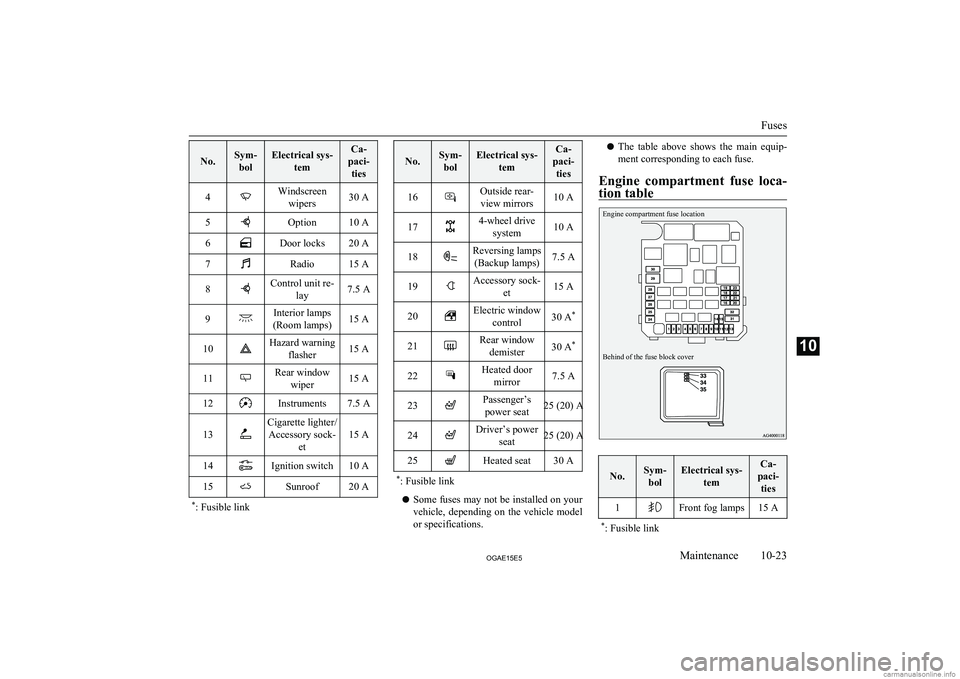
No.Sym-bolElectrical sys- temCa-
paci- ties4Windscreen wipers30 A5Option10 A6Door locks20 A7Radio15 A8Control unit re- lay7.5 A9Interior lamps
(Room lamps)15 A10Hazard warning flasher15 A11Rear windowwiper15 A12Instruments7.5 A13
Cigarette lighter/Accessory sock- et
15 A14Ignition switch10 A15Sunroof20 A*: Fusible link
No.Sym-
bolElectrical sys- temCa-
paci- ties16Outside rear-view mirrors10 A174-wheel drive system10 A18Reversing lamps(Backup lamps)7.5 A19Accessory sock- et15 A20Electric windowcontrol30 A *21Rear window
demister30 A *22Heated door
mirror7.5 A23Passenger’spower seat25 (20) A24Driver’s power seat25 (20) A25Heated seat30 A*: Fusible link
l Some fuses may not be installed on your
vehicle, depending on the vehicle model
or specifications.
l The table above shows the main equip-
ment corresponding to each fuse.
Engine compartment fuse loca-
tion tableEngine compartment fuse locationBehind of the fuse block cover
No.Sym- bolElectrical sys- temCa-
paci- ties1Front fog lamps15 A* : Fusible link
Fuses
10-23OGAE15E5Maintenance10
Page 382 of 452

No.Sym-bolElectrical sys- temCa-
paci- ties2Engine7.5 A3Automatic trans- mission20 A4Horn10 A5Alternator7.5 A6Headlamp wash- er20 A7Air conditioning10 A
8
ETV/Oil coolerfan
(Twin Clutch SST)
15 A
9Security horn20 A10Wiper de-icer15 A11———12Electric tailgate30 A13Daytime running lamps10 A14Headlamp high-beam (left)10 A*: Fusible link
No.Sym-
bolElectrical sys- temCa-
paci- ties15Headlamp high- beam (right)10 A
16
Head-lamp low
beam (left)
Dis-
charge20 A17
Head- lamp low
beam
(right)
Dis-
charge20 A18
Head- lamp low
beam (left)
Halo- gen10 A19
Head-lamp low
beam
(right)
Halo- gen10 A
20ENG/POWER10 A21Ignition coil10 A*: Fusible link
No.Sym-
bolElectrical sys- temCa-
paci- ties
22
ENG/POWER20 AFuel line heater25 A23Fuel pump15 A24Starter30 A *25———26Anti-lock brake
system40 A *27Anti-lock brake
system30 A *28
Air conditioning
condenser fan motor
30 A *29Radiator fan mo-
tor40 A*30IODIOD30 A31Audio system
amp30 A32Diesel30 A33—Spare fuse10 A34—Spare fuse15 A*: Fusible link
Fuses
10-24OGAE15E5Maintenance10
Page 383 of 452
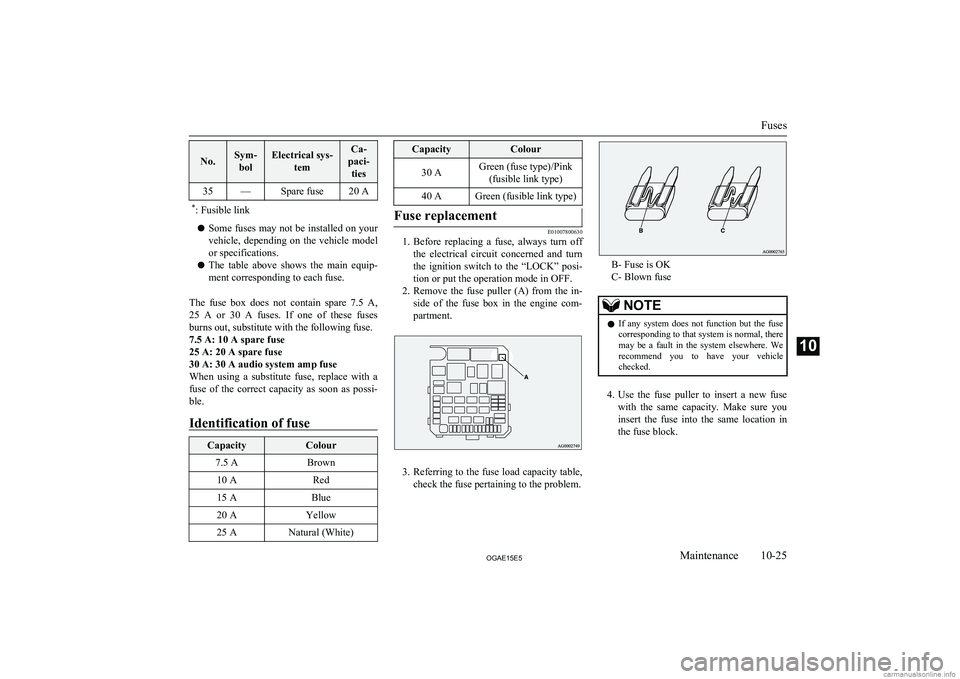
No.Sym-bolElectrical sys- temCa-
paci- ties35—Spare fuse20 A* : Fusible link
l Some fuses may not be installed on your
vehicle, depending on the vehicle model
or specifications.
l The table above shows the main equip-
ment corresponding to each fuse.
The fuse box does not contain spare 7.5 A ,
25 A or 30 A fuses. If one of these fuses burns out, substitute with the following fuse.7.5 A: 10 A spare fuse
25 A: 20 A spare fuse
30 A: 30 A audio system amp fuse
When using a substitute fuse, replace with a
fuse of the correct capacity as soon as possi- ble.
Identification of fuse
CapacityColour7.5 ABrown10 ARed15 ABlue20 AYellow25 ANatural (White)CapacityColour30 AGreen (fuse type)/Pink (fusible link type)40 AGreen (fusible link type)Fuse replacement
E01007800630
1. Before replacing a fuse, always turn off
the electrical circuit concerned and turn
the ignition switch to the “LOCK” posi-
tion or put the operation mode in OFF.
2. Remove the fuse puller (A) from the in-
side of the fuse box in the engine com-
partment.
3. Referring to the fuse load capacity table,
check the fuse pertaining to the problem.
B- Fuse is OK
C- Blown fuse
NOTEl If any system does not function but the fuse
corresponding to that system is normal, theremay be a fault in the system elsewhere. We recommend you to have your vehiclechecked.
4. Use the fuse puller to insert a new fuse
with the same capacity. Make sure you
insert the fuse into the same location in
the fuse block.
Fuses
10-25OGAE15E5Maintenance10
Page 397 of 452
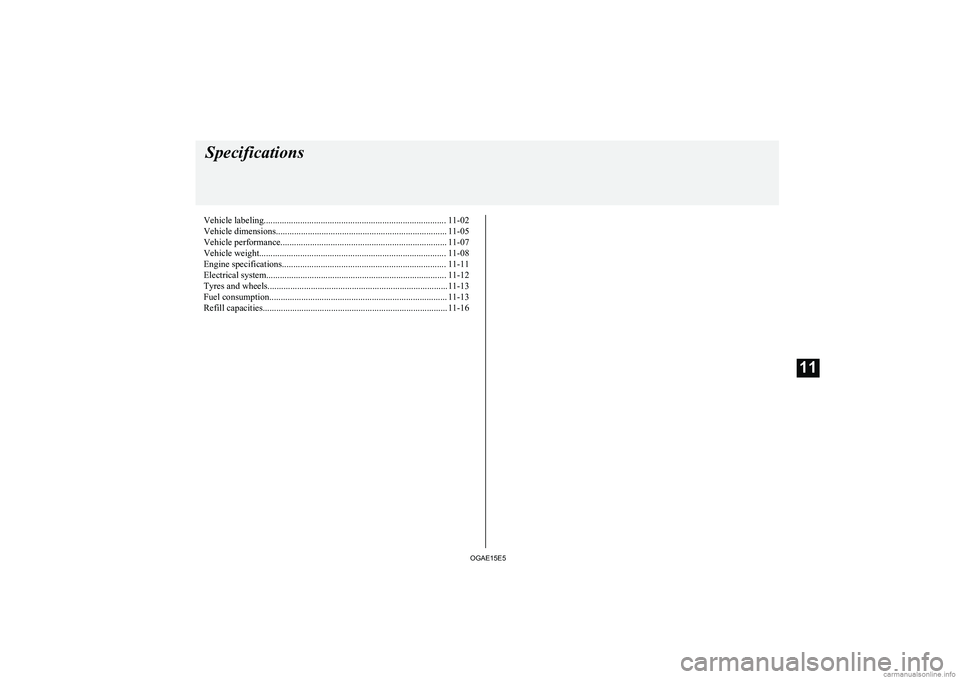
Vehicle labeling................................................................................ 11-02
Vehicle dimensions........................................................................... 11-05
Vehicle performance......................................................................... 11-07 Vehicle weight.................................................................................. 11-08
Engine specifications........................................................................ 11-11
Electrical system............................................................................... 11-12
Tyres and wheels...............................................................................11-13
Fuel consumption.............................................................................. 11-13
Refill capacities................................................................................. 11-16Specifications
OGAE15E511
Page 398 of 452

Vehicle labelingE01100104747
Vehicle identification number
The vehicle identification number is stamped on the bulkhead as shown in the illustration.
Vehicle information code la-
bel*
The vehicle information code label is located as shown in the illustration.
The label shows model code, engine model,
transmission model and body colour code,
etc.
Please use this number when ordering re-
placement parts.
1- Model code
2- Engine model code
3- Exterior code
4- Transmission model code
5- Body colour code, Interior code,
Option code
6- Chassis number
7- Maximum gross vehicle weight
8- Gross combination weight
9- Maximum axle weight (Front)
10- Maximum axle weight (Rear)
Vehicle labeling
11-02OGAE15E5Specifications11